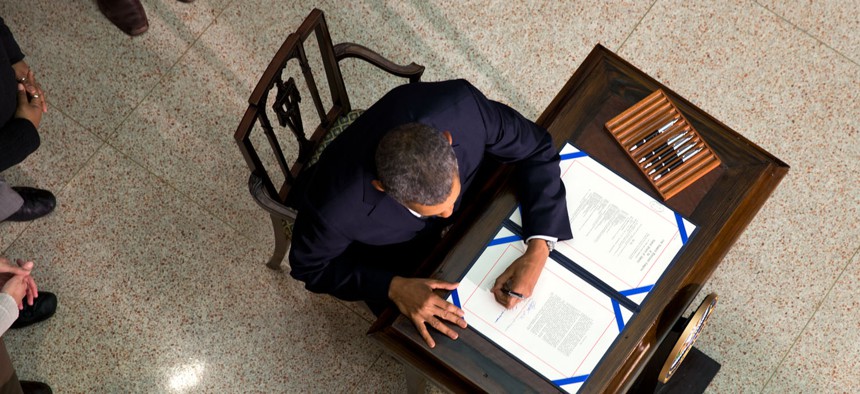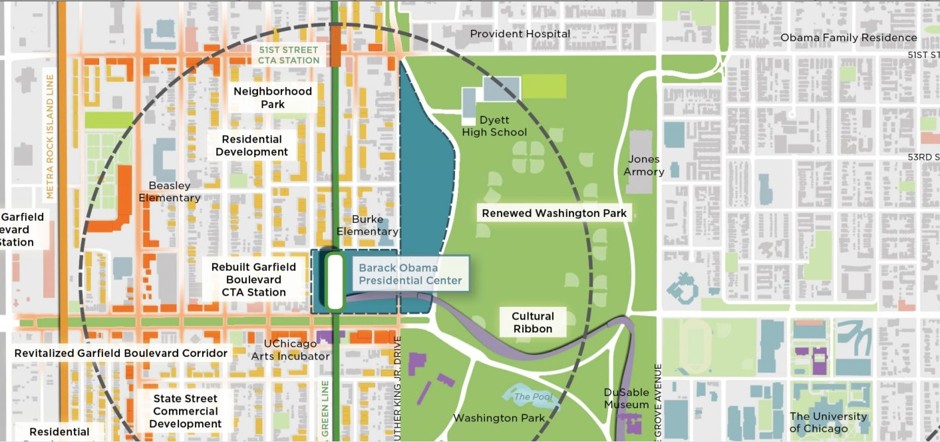
Obama signs a bill in 2014 in the New Executive Office Building. Lawrence Jackson/White House file photo
Why the Obama Presidential Library Is Bound To Fail
It will be beautiful, sure. But Chicago leaders are horse-trading with the cultural resources of poorer neighborhoods when it comes to location.
Chicago took a blow this week as the architects selected as finalists to design the library for President Barack Obama in Chicago were announced. Just one of the seven architects named by the Barack Obama Foundation is from Chicago.
“The dearth of Chicago finalists was a disappointment for the city, which takes great pride in the pioneering role it played in the development of modern architecture and in such contemporary projects as Millennium Park,” writes theChicago Tribune’s Blair Kamin.
The woman widely thought to be the clear frontrunner for the job, MacArthur Fellow and Chicagoan Jeanne Gang, didn’t even make the cut. Still, the list is impressive. John Ronan Architects, the sole firm repping Chicago, is joined in the finalist bracket by four New York–based firms: Diller Scofidio + Renfro (the firm that co-designed the High Line), Tod Williams Billie Tsien Architects(Philadelphia’s Barnes Foundation), SHoP Architects (the Barclays Center), and Snøhetta (the San Francisco Museum of Modern Art addition).
Two more architects hailing from Europe round out this fellowship: Renzo Piano, who designed the new Whitney Museum of American Art, and David Adjaye, who designed the National Museum of African American History and Culture. With the exception of Snøhetta and SHoP, all of these architects have significant projects on the ground in Chicago. There’s no way that the Barack Obama Presidential Center is going to disappoint.
And yet the site selection is so compromised that whatever gets built there will be compromised as well. Both of the sites on Chicago’s South Side still under consideration involve carving room out of existing historic park space. The Barack Obama Presidential Center is setting a dangerous precedent by showing how power forces the public to yield.

Two proposed sites for the Barack Obama Presidential Center. (The University of Chicago)
Jackson Park and Washington Park—the two sites being considered for the library—are both historic 19th-century parks. Frederick Law Olmsted and Calvert Vaux, the landscape architects behind Central Park, designed both of these sites. These parks are well loved by the people who live near them, visit them, and use them every day. North Chicago has more parks and richer parksthan the South Side, making these two parks potentially more valuable to South Side residents.
Building the Barack Obama Presidential Center would require taking 20 acres from one or the other. That’s a massive public subsidy: Washington Park in particular ranks up there with Central Park in historic significance. The city of Chicago never even had an opportunity to debate this proposal. Chicago Mayor Rahm Emanuel, who pledged to move “heaven and earth” to get the library in Chicago, drafted the bill that would allow Chicago parkland to be used for a presidential library. The Illinois legislature passed the bill within a single day.
No organization in the country could buy these priceless cultural assets, and yet the city aims to give parts of them away.
The argument for building President Obama’s presidential library on the South Side is strong. It will bring jobs and tourism to an area that lacks in both. It will call back to the president’s work in Chicago as a community organizer in his youth. It will no doubt shine as a beacon of pride for Woodlawn or other park-adjacent neighborhoods. And judging by the Obamas’ taste in architects, it will be a destination for modern architecture.
But it will prove that things that are sacred in affluent northern Chicago can be taken for granted on the South Side. (Try to imagine Mayor Emanuel and President Obama angling to slide a presidential library into Grant Park.) As CityLab reported back in May, plenty of people have rejected the city-state-federal decision to carve up Jackson Park or Washington Park. Advocacy groups such as Friends of the Parks and the Cultural Landscape Foundation oppose the plan, as does The Boston Globe and The Chicago Maroon, the student newspaper for the University of Chicago. But nobody’s listening to them.
The reasons for putting a presidential library in an historic 19th-century park are clear: It’s free landscape architecture. Essentially, the Barack Obama Foundation gets an Olmsted park for its yard as part of the bargain. This should bother Chicagoans, because the foundation won’t be building something that it otherwise would be required to build: an improved, worthy cultural landscape fit for a presidential library. Carving out historic parkland means making fewer improvements in Woodlawn or the Washington Park area. Instead of building up the community, the foundation (and the city) have instead chosen the mostimproved parts of the area and offered one up for the taking.

How the presidential library would carve land out of Washington Park. (The University of Chicago)
There are many alternatives for a presidential library. One idea might have been to build on the parcel outside Washington Park and adopt the recently shuttered Dyett High School building, which is tucked inside park borders just around the corner of Martin Luther King Jr. Drive and 51st Street. That building combines two Chicago institutions: It was designed by David Haid, a protégé of Mies van der Rohe, and it was depicted in Ferris Bueller’s Day Off. Moreover, Southeast Side residents badly needed the city to do something with the building: In the fall, a community group organized a 34-day hunger strikeprotesting the closure of the school. (In this case, the city relented and agreed to reopen the school.)
That’s just one example. Another solution would be for the Barack Obama Foundation to simply buy a parcel and develop it honestly. There are nearly 80 acres of vacant city-owned land in the Washington Park area and more than 60 acres of vacant land in Woodlawn. Why not improve upon some of them?
It should worry Chicagoans that the mayor, operating without any checks, is able to horse-trade with the valuable cultural resources of poorer neighborhoods. It sets a bad precedent for these specific parks, and it sets a bad precedent for presidential libraries to come. The specific goal in luring a presidential library to the South Side is to create new valuable cultural resources, not cut costs for the Obamas. And the goal in building a presidential library is to honor those values for which the president stands, not indulge in greedy politics.
It’s ironic that the Barack Obama Foundation is responsible for denying the South Side the opportunity to organize to discuss the best options for the Washington Park and Jackson Park communities. When it’s completed, the Barack Obama Presidential Center is bound to gorgeous, but it has already failed the community it is supposed to serve.






